The Design Quartet: Educational cards that students actually use
Case study by
Max van IJsselmuiden
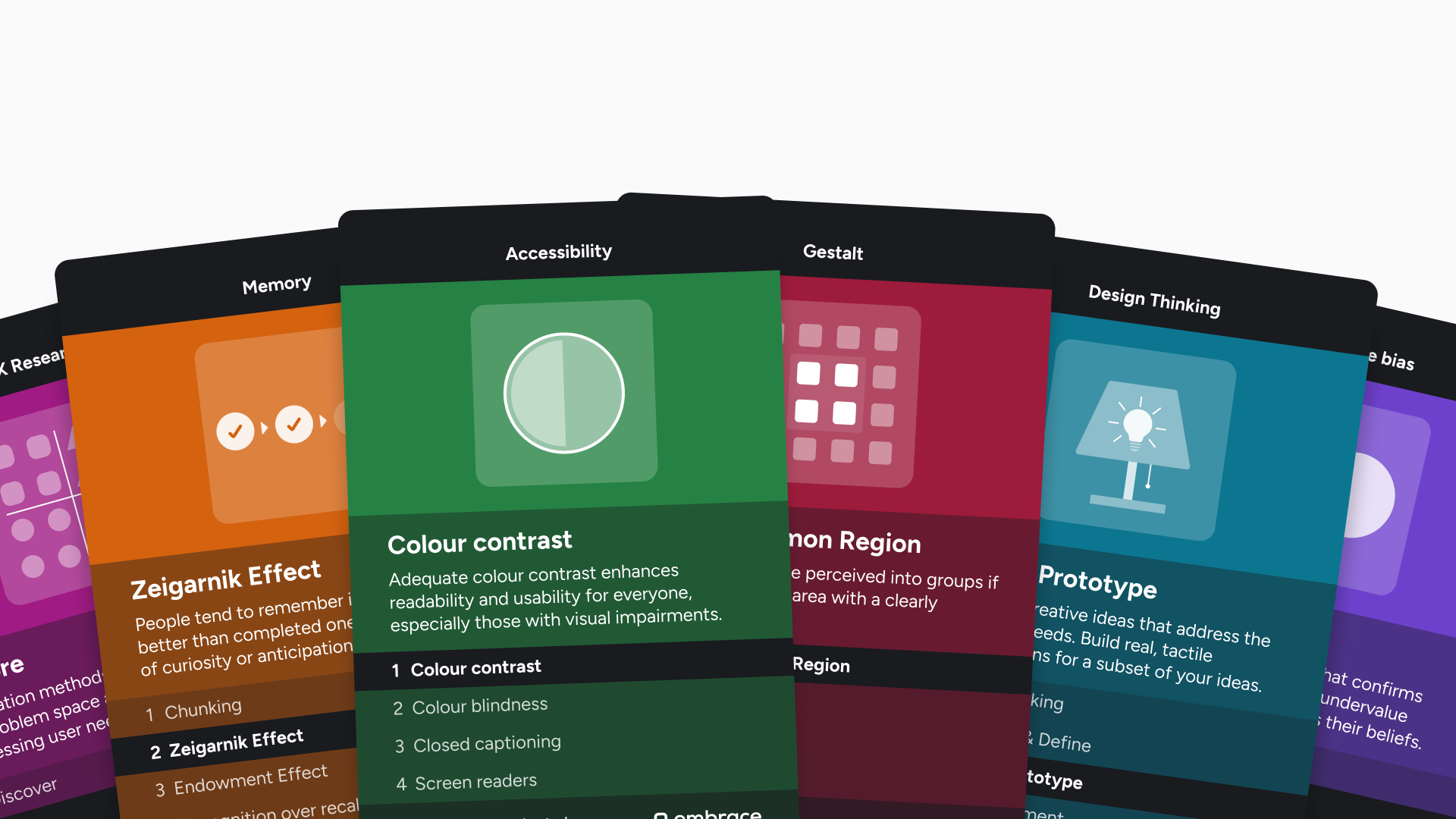
Role
Product Designer
Challenge
Create an engaging educational tool that reinforces design principles while building brand awareness among emerging talent
Impact
Memorable learning resource that sparked genuine appreciation from students and strengthened Embrace's presence in education
Period
2023 - 2025
As part of my educational initiatives at Embrace - The Human Cloud, we developed a design principles quartet card game that serves dual purposes: reinforcing key UX concepts for students and creating lasting brand connections with emerging talent. Honestly, we tried creating something students would actually keep and use, something that felt more useful than yet another typical corporate ‘gift’.

For context: through my University of Groningen background, I connected with PhD M.B. Schippers (Coordinator external relations for Artificial Intelligence and Computational Cognitive Science) to discuss supporting her courses. This led to workshop opportunities across multiple programs: Cognitive Ergonomics Practical, User-Centred Design, and Information Science at Groningen.
The learning challenge
While planning the first ideation workshops, we brainstormed how to create a meaningful gift for students that would serve both educational and marketing purposes. Traditional handouts get lost or forgotten, but we needed something students would actually use and remember.
The challenge was creating an educational tool that would:
- Encourage discussion about design principles
- Remain useful as a long-term reference
- Create positive brand associations with Embrace
Why quartet?
The quartet format solved multiple problems simultaneously. Everyone knows how to play quartet, meaning no learning curve for the game mechanics. Furthermore, the format naturally encourages discussion and comparison between different design principles. The familiar game format meant students would engage with the content rather than letting it collect dust on a shelf.
Content strategy
Inspired by Jon Yablonski's Laws of UX, we curated design principles organized into several thematic categories, selecting the most practical and commonly-referenced concepts in UX design:
Gestalt
Visual perception principles that explain how users naturally group and interpret interface elements.
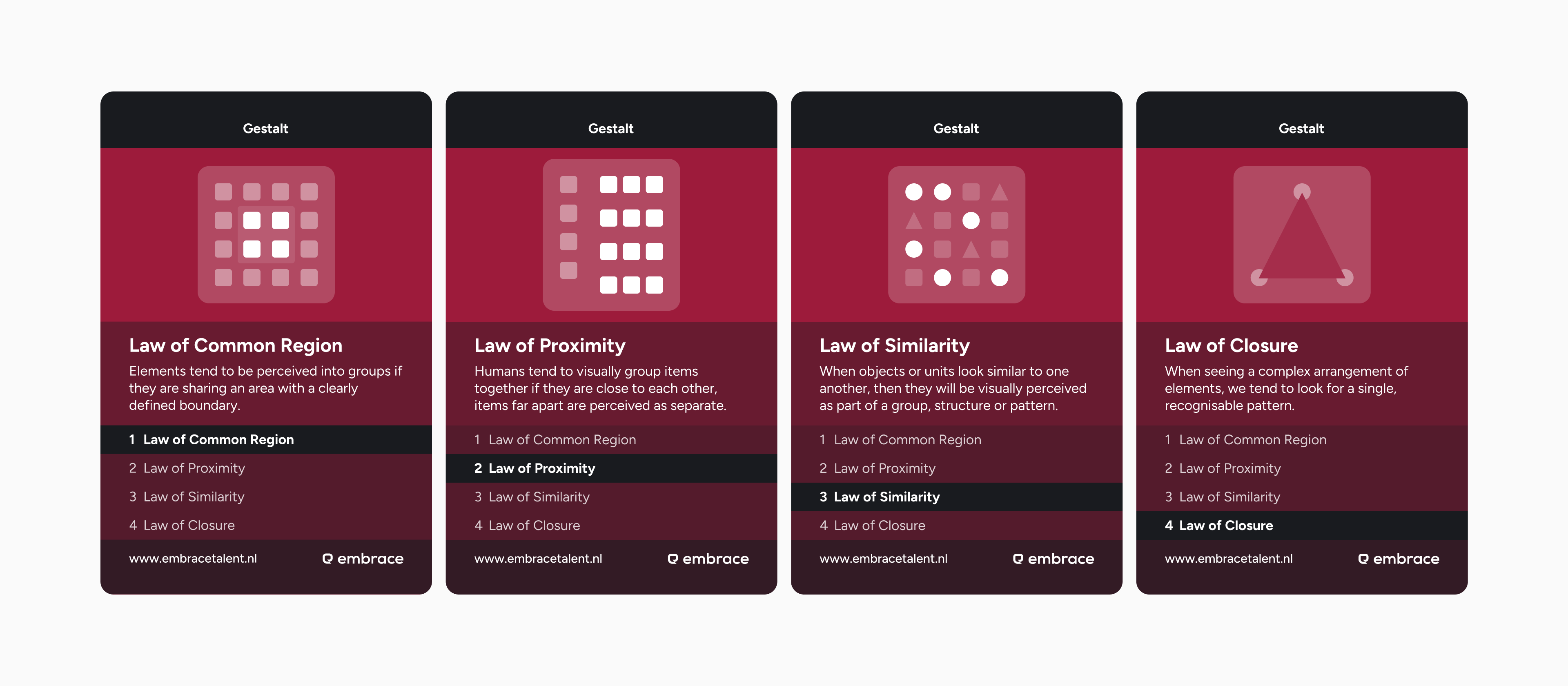
Law of Common Region, Law of Proximity, Law of Similarity and Law of Closure.
UX Research
Research methodology cards covering the discovery, exploration, testing, and listening phases of user research.
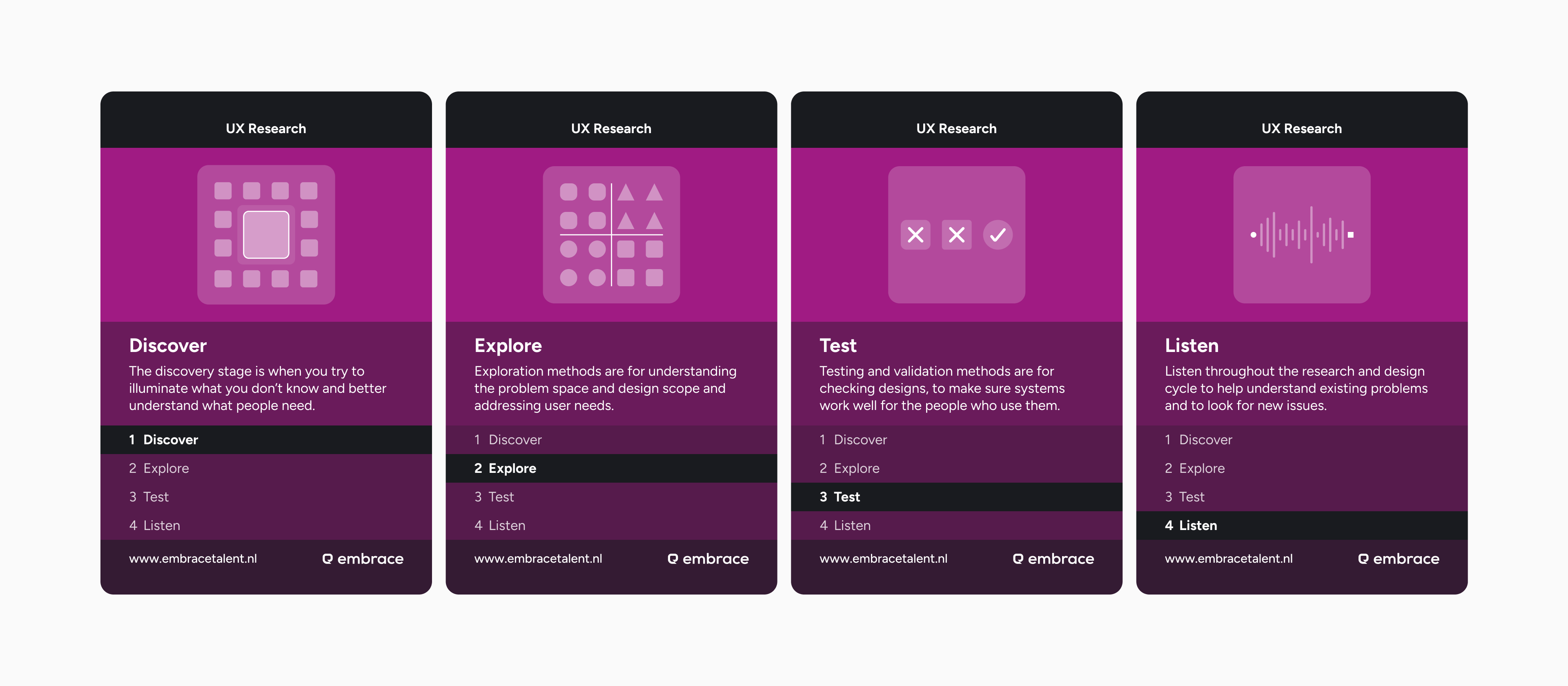
Discover, Explore, Test and Listen.
User Delight
Principles for creating engaging experiences across visceral, behavioral, and reflective levels of user interaction.
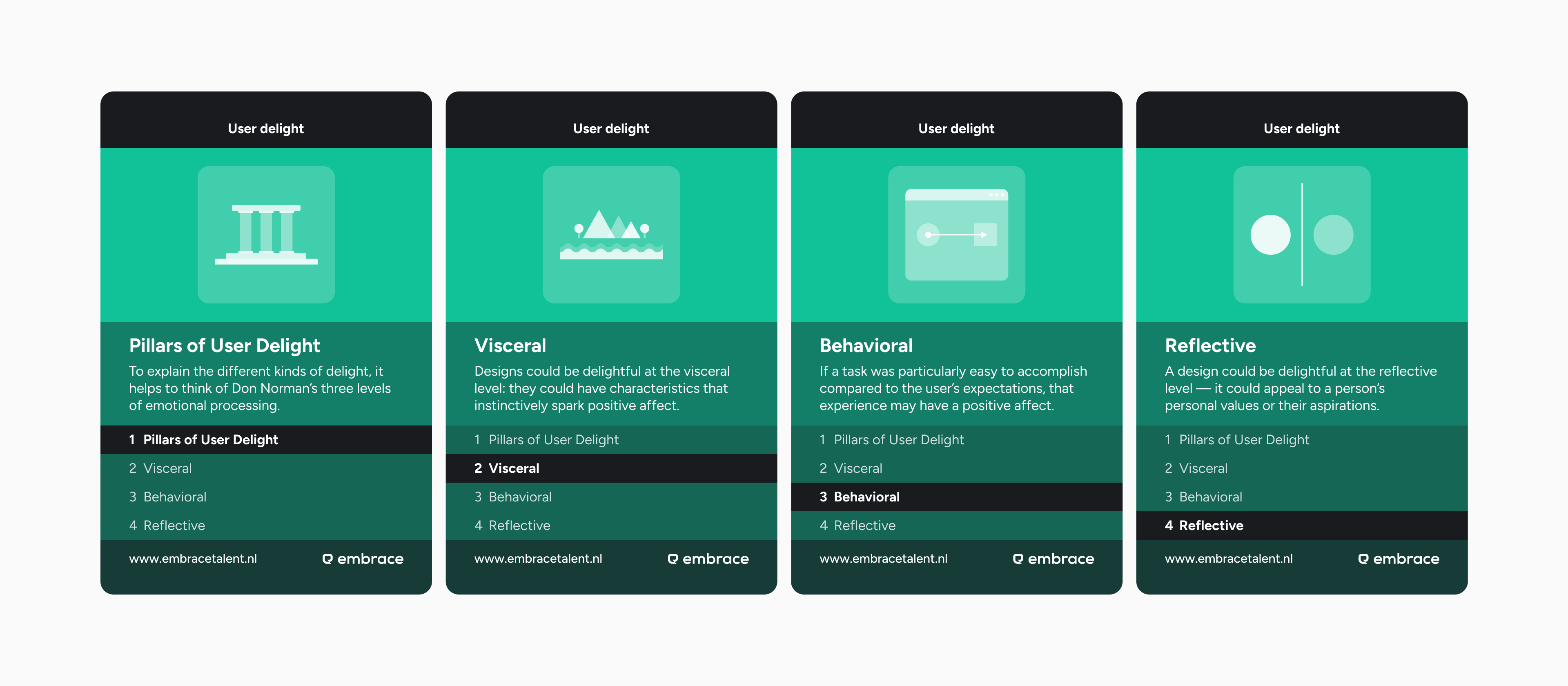
Pillars of User Delight, Visceral, Behavioral and Reflective.
Design Thinking
Foundational methodology cards that guide students through the human-centered design process from empathy to iteration.

Design Thinking, Empathize & Define, Ideate & Prototype, Test & Implement.
Cognitive Bias
Psychological principles that help designers understand how mental shortcuts and biases influence user decision-making.
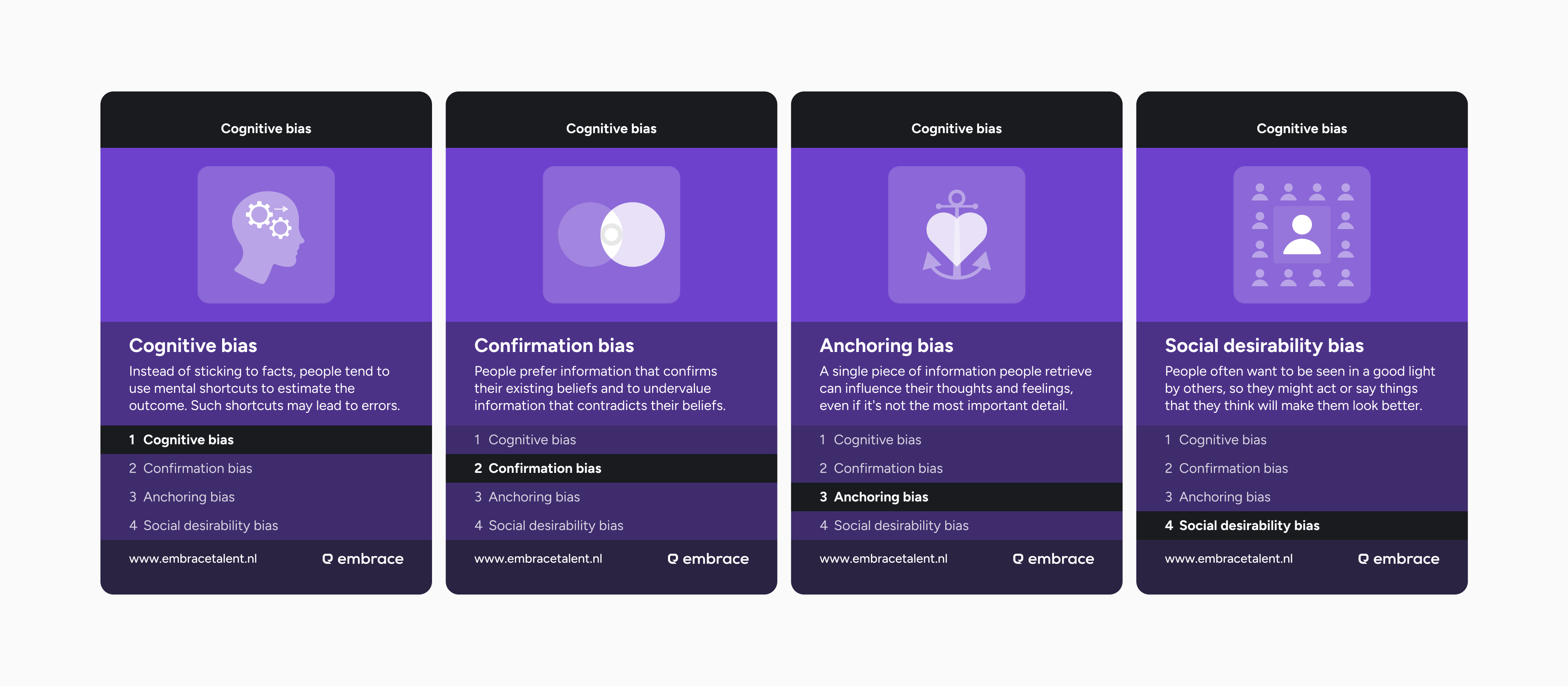
Cognitive bias, Confirmation bias, Anchoring bias and Social desirability bias.
Heuristics
Established UX laws that provide practical guidelines for interface design and user interaction patterns.
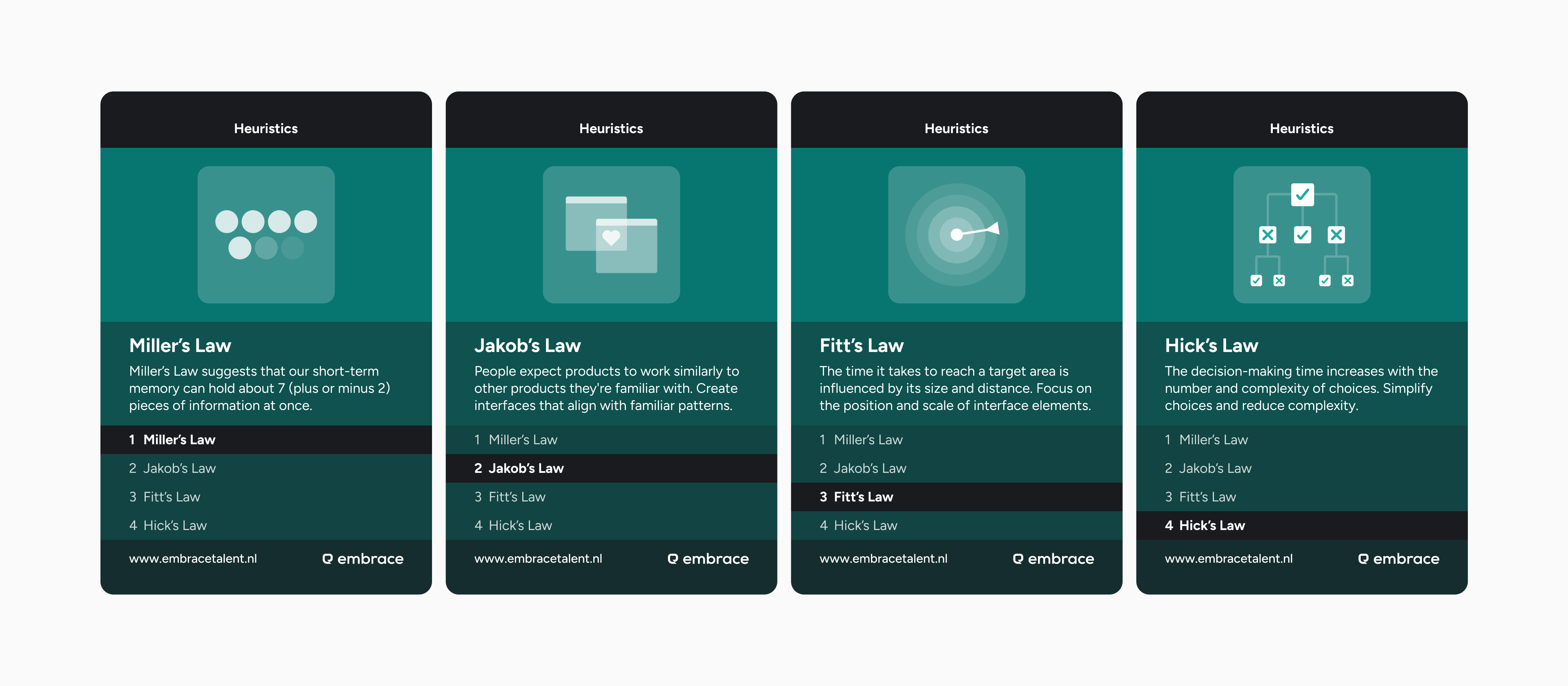
Miller’s Law, Jakob’s Law, Fitt’s Law, and Hick’s Law.
Accessibility
Essential considerations for creating inclusive designs that work for users with diverse abilities and needs.
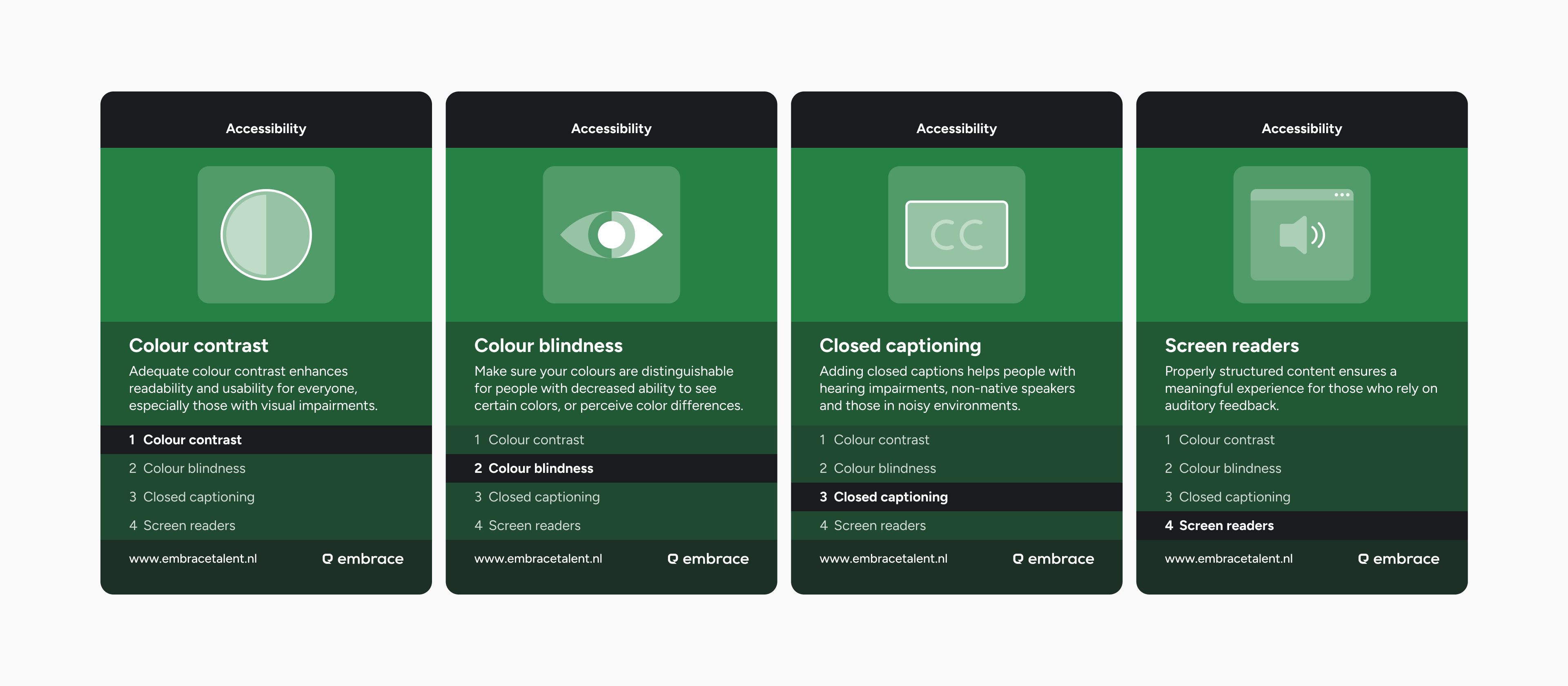
Colour contrast, Colour blindness, Closed captioning and Screen readers.
Inclusive design
Broader inclusion concepts that extend beyond accessibility to address diverse perspectives and experiences.
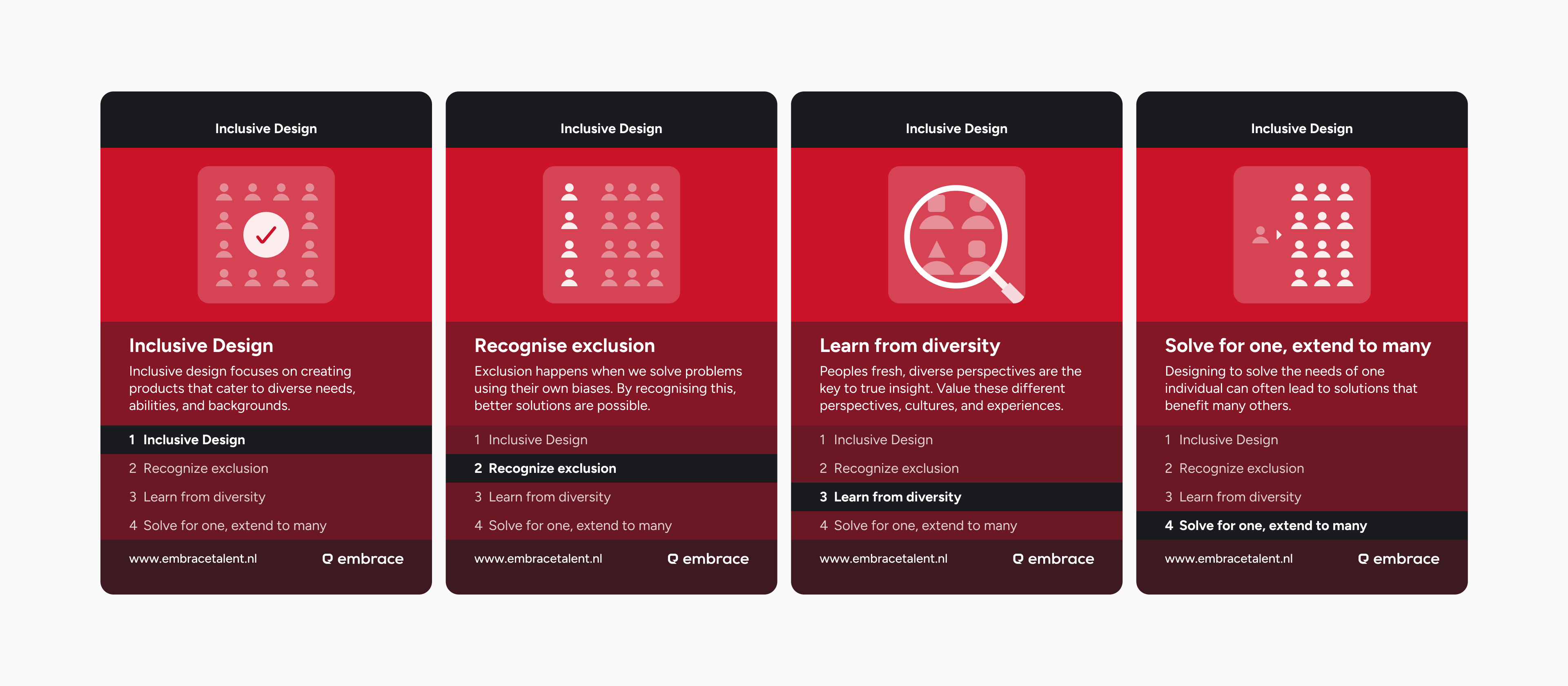
Inclusive Design, Recognize Exclusion, Learn from diversity and ‘Solve for one, extend to many’.
Usability
Core usability principles and psychological effects that impact how users interact with digital interfaces.
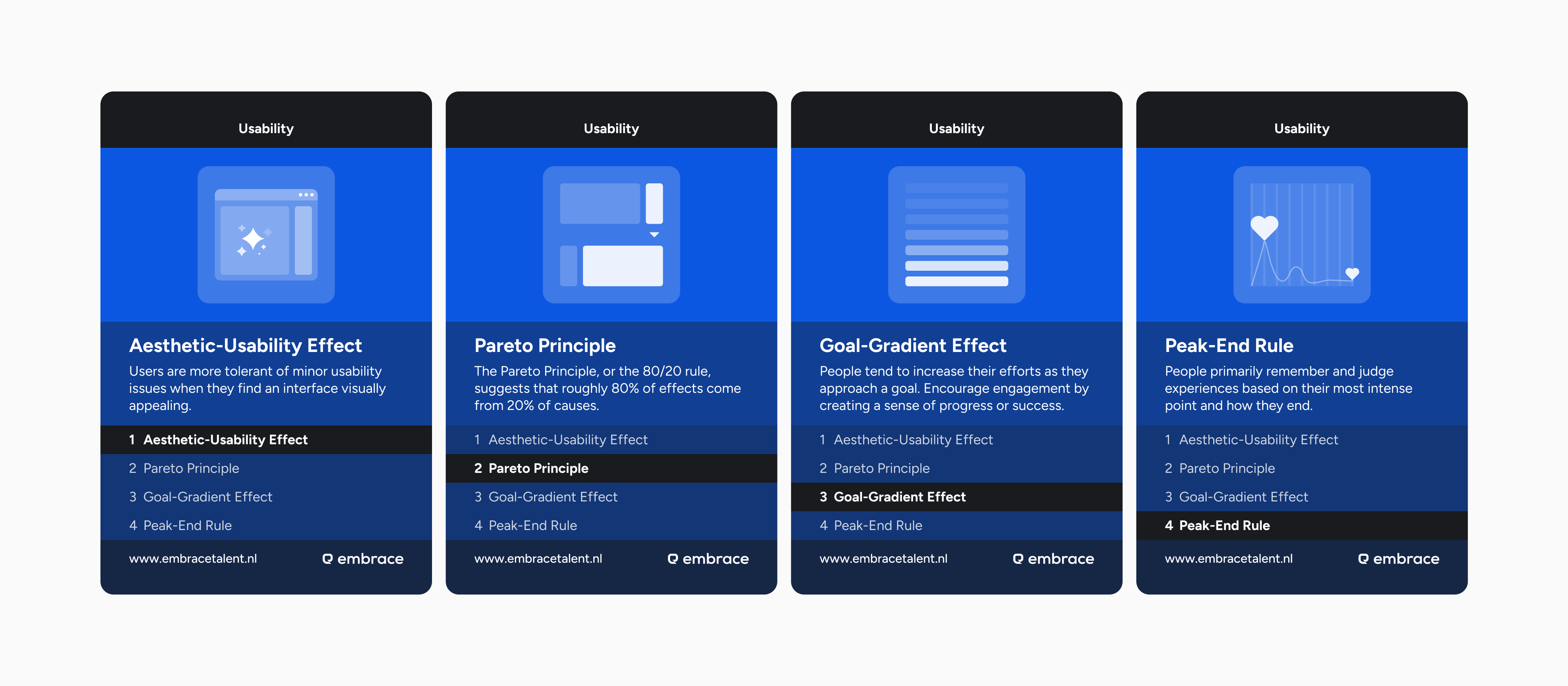
Aesthetic-Usability Effect, Pareto Principle, Goal-Gradient Effect, Peak-End Rule
Memory
Cognitive concepts that inform how users process, retain, and recall information in digital experiences.
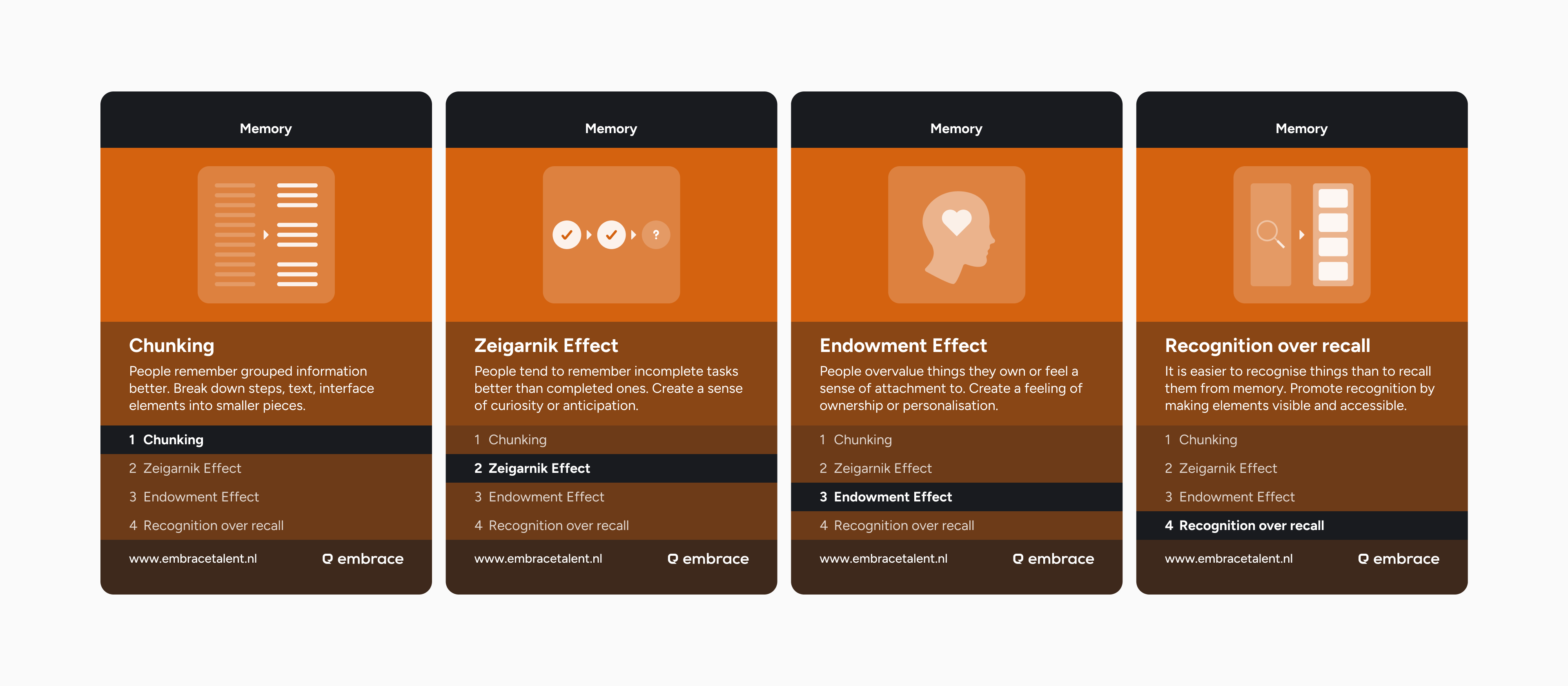
Chunking, Zeigarnik Effect, Endowment Effect and Recognition over recall.
Each card includes a clear explanation and visual representation, making complex concepts accessible to students at different experience levels. The selection focused on principles that students would encounter regularly in their design work and studies.
Content was research-based, drawing from authoritative sources including Nielsen Norman Group, Microsoft's Inclusive Design guidelines, and MDN web doc’s resources.
Design approach
The very talented coworker Isaï created the illustrations that bring each principle to life visually. Seeing the illustration skills of Isaï come to life is always great, making complex concepts easily understandable.
Each category uses distinct color coding for easy recognition. The visual hierarchy emphasizes the principle name and provides concise, actionable descriptions. Simple and clear.
Distribution and reception
We distributed the cards at workshops and guest lectures as memorable takeaways. Student reaction consistently exceeded expectations, as they were genuinely surprised by the effort and quality of the educational resource.
Rather than typical promotional materials, students appreciated receiving something genuinely useful for their studies and future careers. The cards function both as active learning tools and valuable reference materials they can revisit throughout their design education.
Strategic outcomes
For Embrace, the quartet game established a unique position. These cards provide ongoing value while maintaining subtle but consistent brand presence.
The project demonstrates Embrace's innovative and ‘project ownership’ strengths, we pitched the idea and were continuously positively reinforced. Students associate the brand with thoughtful, high-quality educational resources rather than generic recruitment materials.
Lessons learned
Successful educational marketing requires genuine value creation. Students respond positively when companies invest in their learning rather than just promoting services or job openings.
Despite having access to countless online resources, students valued having tangible reference cards they could use during projects and discussions.
The best learning happens through engagement and discussion, not passive consumption.
Effective talent acquisition in creative fields requires demonstrating expertise and commitment to the discipline.
Lorem ipsum
Did you like this post?
Want to stay tuned?
The Design Quartet: Educational cards that students actually use
Case study by
Max van IJsselmuiden

Role
Product Designer
Challenge
Create an engaging educational tool that reinforces design principles while building brand awareness among emerging talent
Impact
Memorable learning resource that sparked genuine appreciation from students and strengthened Embrace's presence in education
Period
2023 - 2025
As part of my educational initiatives at Embrace - The Human Cloud, we developed a design principles quartet card game that serves dual purposes: reinforcing key UX concepts for students and creating lasting brand connections with emerging talent. Honestly, we tried creating something students would actually keep and use, something that felt more useful than yet another typical corporate ‘gift’.

For context: through my University of Groningen background, I connected with PhD M.B. Schippers (Coordinator external relations for Artificial Intelligence and Computational Cognitive Science) to discuss supporting her courses. This led to workshop opportunities across multiple programs: Cognitive Ergonomics Practical, User-Centred Design, and Information Science at Groningen.
The learning challenge
While planning the first ideation workshops, we brainstormed how to create a meaningful gift for students that would serve both educational and marketing purposes. Traditional handouts get lost or forgotten, but we needed something students would actually use and remember.
The challenge was creating an educational tool that would:
- Encourage discussion about design principles
- Remain useful as a long-term reference
- Create positive brand associations with Embrace
Why quartet?
The quartet format solved multiple problems simultaneously. Everyone knows how to play quartet, meaning no learning curve for the game mechanics. Furthermore, the format naturally encourages discussion and comparison between different design principles. The familiar game format meant students would engage with the content rather than letting it collect dust on a shelf.
Content strategy
Inspired by Jon Yablonski's Laws of UX, we curated design principles organized into several thematic categories, selecting the most practical and commonly-referenced concepts in UX design:
Gestalt
Visual perception principles that explain how users naturally group and interpret interface elements.

Law of Common Region, Law of Proximity, Law of Similarity and Law of Closure.
UX Research
Research methodology cards covering the discovery, exploration, testing, and listening phases of user research.

Discover, Explore, Test and Listen.
User Delight
Principles for creating engaging experiences across visceral, behavioral, and reflective levels of user interaction.

Pillars of User Delight, Visceral, Behavioral and Reflective.
Design Thinking
Foundational methodology cards that guide students through the human-centered design process from empathy to iteration.

Design Thinking, Empathize & Define, Ideate & Prototype, Test & Implement.
Cognitive Bias
Psychological principles that help designers understand how mental shortcuts and biases influence user decision-making.

Cognitive bias, Confirmation bias, Anchoring bias and Social desirability bias.
Heuristics
Established UX laws that provide practical guidelines for interface design and user interaction patterns.

Miller’s Law, Jakob’s Law, Fitt’s Law, and Hick’s Law.
Accessibility
Essential considerations for creating inclusive designs that work for users with diverse abilities and needs.

Colour contrast, Colour blindness, Closed captioning and Screen readers.
Inclusive design
Broader inclusion concepts that extend beyond accessibility to address diverse perspectives and experiences.

Inclusive Design, Recognize Exclusion, Learn from diversity and ‘Solve for one, extend to many’.
Usability
Core usability principles and psychological effects that impact how users interact with digital interfaces.

Aesthetic-Usability Effect, Pareto Principle, Goal-Gradient Effect, Peak-End Rule
Memory
Cognitive concepts that inform how users process, retain, and recall information in digital experiences.

Chunking, Zeigarnik Effect, Endowment Effect and Recognition over recall.
Each card includes a clear explanation and visual representation, making complex concepts accessible to students at different experience levels. The selection focused on principles that students would encounter regularly in their design work and studies.
Content was research-based, drawing from authoritative sources including Nielsen Norman Group, Microsoft's Inclusive Design guidelines, and MDN web doc’s resources.
Design approach
The very talented coworker Isaï created the illustrations that bring each principle to life visually. Seeing the illustration skills of Isaï come to life is always great, making complex concepts easily understandable.
Each category uses distinct color coding for easy recognition. The visual hierarchy emphasizes the principle name and provides concise, actionable descriptions. Simple and clear.
Distribution and reception
We distributed the cards at workshops and guest lectures as memorable takeaways. Student reaction consistently exceeded expectations, as they were genuinely surprised by the effort and quality of the educational resource.
Rather than typical promotional materials, students appreciated receiving something genuinely useful for their studies and future careers. The cards function both as active learning tools and valuable reference materials they can revisit throughout their design education.
Strategic outcomes
For Embrace, the quartet game established a unique position. These cards provide ongoing value while maintaining subtle but consistent brand presence.
The project demonstrates Embrace's innovative and ‘project ownership’ strengths, we pitched the idea and were continuously positively reinforced. Students associate the brand with thoughtful, high-quality educational resources rather than generic recruitment materials.
Lessons learned
Successful educational marketing requires genuine value creation. Students respond positively when companies invest in their learning rather than just promoting services or job openings.
Despite having access to countless online resources, students valued having tangible reference cards they could use during projects and discussions.
The best learning happens through engagement and discussion, not passive consumption.
Effective talent acquisition in creative fields requires demonstrating expertise and commitment to the discipline.
Every now and then I still look through these cards to get back to one of the principles, or to help explaining them to others. A great and functional product!
Did you like this post?
Want to stay tuned?
